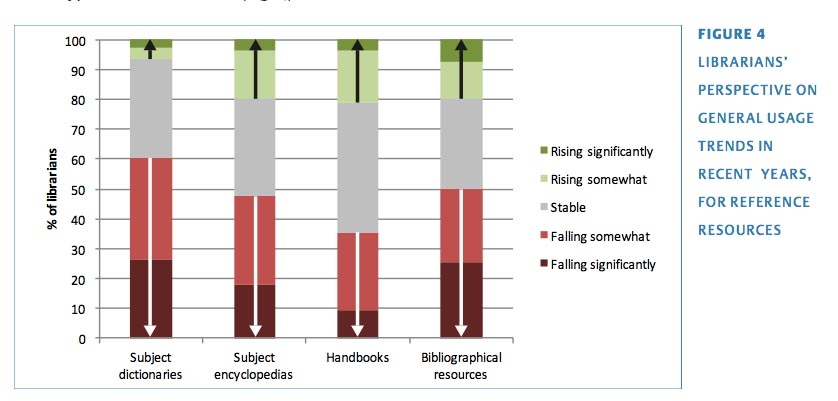The category of learned publications we have come to know as “reference works” is ripe for innovation, perhaps even overripe. A recent study from Oxford University Press (OUP) further documents the decline of reference products as a distinct content type, and illuminates fertile ground for an inventive approach to modern, contextual resources that serve today’s scholarly information needs.
Based on US and UK end-user interviews plus an academic librarian survey, the OUP report is another installment in a growing collection of literature measuring the declining interest in library and publisher reference resources by today’s users. They cite similar findings from Project Information Literacy and others that establish changing information-seeking practices of today’s scholarly readers, many reinforcing the time pressures of most users and establishing the open-web as starting point for swift answers in the academic workflow.

With the ubiquity of Wikipedia and Google solving our quick-check needs for factual information, this OUP study tracks the continued decrease in students and researchers seeking library resources they identify as “reference.” While there are important variations between younger students and more advanced academic readers, most users continue to expect fast, relevant search results at the point of need. Participants reported to OUP that they use the mainstream web and other search engines to explore key terms and “get a general sense of the conversation” (p. 6).
Some students and faculty in this study reported concerns and limitations in freely available reference sources. From my own research, I have learned that this is often due to the questionable authority of some sites and the validity of citing these resources – judgements that likely vary across regions and disciplines. With a targeted sample, in a traditionally limited sample size, the OUP study applied Carnegie classifications to differentiate responses by type and size of institution. While these distinctions are not directly addressed in the paper, this data holds promise for deeper analysis on the ways in which reference needs and practices across universities and colleges.
Despite recent technological and market changes, OUP’s report is one in a series that demonstrates how students at all levels, in particular undergraduates, reach critical developmental milestones and learning thresholds that demand support from materials that define topics and connect the dots at key stages of the learning process. However, providing the right contextual material at the right time is a logistical challenge for publishers and librarians alike. The “reference interview” is still a key opportunity to help students formulate their research questions and guide their use of scholarly information. Librarians have been working to reinvent the reference desk for years now and finding success with a librarians-as-consultants model that aim to empower users to “take ownership of their research skills” (p. 10).
Publishers and technologists, however, still have a way to go to truly rethink reference product lines and try out new approaches to digital resources and tools that support foundational information needs. The report affirms, “as the routes by which users access scholarly content continue to change, the discoverability of reference resources is likely to be an ever-evolving challenge for users, librarians, and publishers” (p. 17). I would go a few steps further and say that, in a time where the success of a publication largely rests on strong usage, we must train our sights on innovating toward services and products that fit smoothly into the scholarly workflow. This demands a strategic focus on content discoverability as well as usability and accessibility (with all its various implications).
As a purveyor of some of the world’s best reference works, OUP has validated the market opportunities for publishers to overhaul their reference divisions in their report. There is clear opportunity to tinker with the design and delivery of bibliographic resources and interdisciplinary materials focused on key topics. While perceptions of quality usage and related benchmarks will vary a great deal across libraries, the relative strength of handbooks’ popularity (see Figure 4 below) is crying out for a revolutionary approach to disciplinary manuals that could become key companions for students throughout their careers.

This data, however, is predicated on the assumption that handbooks and other reference titles must remain as stand-alone units. Whereas technology can enable greater integration of reference works across academic databases to enable findability when and where contextual help is required. Synthesizing some reference works, like dictionaries or encyclopedias, into more advanced scholarly products could provide opportunities to surface answers and definitions as needed. This type of reference “perma-layer” could become a top-up options for journals platforms, for example, reducing the number of stand-alone products students and researchers must navigate.
Search providers and content architects should also find inspiration in this report, as it further highlights a chance to think differently about reference works as a known and desirable category. OUP’s findings herald an occasion for cross-sector creativity in renaming and re-labeling “reference” in a way that speaks to today’s readers and addresses their information needs within the search context. User experience research, information architecture, and metadata modeling are in demand here, as we are plainly not adequately surfacing contextual materials as required in the student workflow.
The focus here should be addressing user search needs for discovering reference materials with “efficiency, comprehensiveness, and familiarity” within their academic info journeys
These findings from OUP prove, among other important details, that current reference models continue to fail many readers, ungraduated students in particular, at important junctions in the academic journey. The library discovery layer is coming of age and, while not designed to serve all possible information practices, discovery providers are uniquely positioned to address the foundational information needs of undergraduates. As students, like those in the OUP study, are not prepared to visit dozens of sites for the definition of a term within framework of their given field, discovery layers are perhaps best suited to offer a variety of definitions and quick answers aggregated from the hundreds of databases in their indices. The focus here should be addressing user search needs for discovering reference materials with “efficiency, comprehensiveness, and familiarity” within their academic info journeys (p. 8).
This is where publishers, libraries, and technologists should embrace innovation as critical to our mission, being willing to flourish is the failure/learning cycle in order to advance the evolution of reference. New approaches to reference would adopt new approaches to delivery and business models – matching current library and reader expectations, not fixated on old assumptions and commercial successes. Investments can be made in breaking out of the isolation of publisher-specific reference products and borrowing from what has worked for open-web reference sites.
There is room for an authoritative, scholarly Wikipedia competitor – as well as ample room for publishers to be smarter about proactively partnering with Wikipedia, as OUP themselves saw as a critical innovation several years ago. I would like to see publishers both recruiting authors to be wiki editors and participating in The Wikipedia Library program.
As one undergraduate told OUP researchers, “‘I think there are a lot of times when I would appreciate something between Wikipedia level and research paper level and that can sometimes be difficult” (p. 13). I hear this as a call to action, publishers! Let’s get creative about rethinking how we deliver reference products! Who’s with me?
Discussion
8 Thoughts on "Tracking the Evolution of Reference Resources"
The lack of clear distinction between reference and non-reference materials and collections in libraries came through in this report, but the reasons for this were not clearly explicated. Many academic libraries are downsizing or even eliminating their physical reference collections (weeding many volumes and incorporating many more into the circulating collection); and in an online environment (meaning both the discovery system and the e-book platforms), there is little distinction made between what is a reference work and what isn’t. This elision of boundaries between reference and non-reference affects users’ perceptions of the kind of books they consult or are willing to consult in their research. In the conclusion, the authors acknowledge that “the category of ‘reference’ is not well understood” – this is perhaps symptomatic of the blending of reference and non-reference works into one general collection. Students who do not clearly understand how a reference work is different from a scholarly monograph may dismiss any book as a potential resource, thinking erroneously that they don’t have time to read a whole book on the topic. This is something libraries as well as platform developers could give some attention to.
Most academic and public libraries already “give some attention to” reference works as distinct from monographs, scholarly journals, and Wikipedia. A lot of attention, actually, among the reference and instruction librarians and listservs I know of.
Thanks.
I meant that we librarians could give attention to how reference works can be represented more distinctly in our discovery systems, now that they don’t often have a separate location or circulation rule associated with them to indicate their status. Sorry if I was unclear.
Just use Google search to locate and identify a book
As the producers of Reference Universe, we are finding that new publication of major reference works is down, but not dramatically so, based, at least, on our incoming metadata to Reference Universe.
Additionally, re: usage, in May 2017, 16% of all inquiries to our service launched an e-book inquiry, compared with 84 % who moved to explore or locate the print edition. This may correspond to an additional finding. As of Spring 2017, there’s a consistent 5:1 ratio of MRWs held in print by academic libraries, compared to e-MRWs—a ratio which holds when looking at ARLs all the way to smaller academic libraries. It is easy to conclude this would reflect heavy print buying in previous years, but it’s worth noting that this was the ratio we found in 2008 as well.
Ultimately, we find they that MRWs are used significantly, but only in those libraries whose practitioners understand their value and direct users to them.
One of the great achievement in reference in the digital age is the open-access Stanford Encyclopedia of Philosophy, which has become the standard reference work in the field for everyone from the general public, to high school and college students, to professional philosophers themselves. It is self-sustaining because its funding comes from an endowment, its articles can be updated whenever the need arises, and each article ends with a bibliography to lead readers to additional sources. Wikipedia is a distant second as a resource for anyone working in philosophy. It would be nice if other fields developed comparable reference works online.
Excellent article Lettie and great timing! Elsevier is launching a new and exciting enhancement that addresses many, if not all, of the points raised in this article called ScienceDirect Topics. As suggested, the foundational content that users need is not always readily discoverable because it is buried deep within book chapters. A researcher can easily be caught up in the morass of siloed information, untrusted sources, and site hopping. Combining technology and content, ScienceDirect Topics is a research enhancement that brings the path of discovery to the user by unlocking this book content. The enhancement offers tens of thousands of free topic pages, each containing key contextual information taken from reference books, providing definitions, snippets and related terms. These pages will be seamlessly hyperlinked from terms within journal articles to create an interactive, seamless and convenient reading experience surfacing answers at point of need. ScienceDirect Topics are also indexed via search engines increasing the discoverability and accessibility of this essential reference content. The enhancement fosters and speeds up insight by bringing comprehensive, credible, and interdisciplinary knowledge within a user’s natural research workflow. ScienceDirect Topics are free to access and are rolling out on several subject domains over the next few months.
William Gibson’s quip about the future (“The future is already here — it’s just not very evenly distributed”) applies to reference publishing. There are fantastic and highly used digital reference resources out there. Sandy Thatcher mentioned one (“Stanford Encyclopedia of Philosophy”). Others I worth noting are McGraw-Hill’s AccessMedicine and related products (AccessPediatrics, AccessEngineering, AccessScience, etc.). These are integrated reference products with textbooks, reference books, databases, and much else undergirded with adaptive learning technology. Knovel from Elsevier is another fantastic engineering resource. Wolters Kluwer’s UpToDate remains a gold standard resource. These are but a few examples. One could compile an extensive list (and many libraries have). There is a divide between publishers that are still thinking of reference as “books” (ebooks are still books) and those that have made the leap to think of reference as digital products (which may no longer resemble books at all). The later are finding success. The former are in decline as users look to web native resources that are more readily discovered and accessed.

